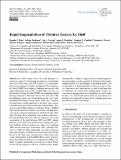Files in this item
Rapid fragmentation of Thwaites Eastern Ice Shelf
Item metadata
| dc.contributor.author | Benn, Douglas I. | |
| dc.contributor.author | Luckman, Adrian | |
| dc.contributor.author | Åström, Jan A. | |
| dc.contributor.author | Crawford, Anna J. | |
| dc.contributor.author | Cornford, Stephen L. | |
| dc.contributor.author | Bevan, Suzanne L. | |
| dc.contributor.author | Zwinger, Thomas | |
| dc.contributor.author | Gladstone, Rupert | |
| dc.contributor.author | Alley, Karen | |
| dc.contributor.author | Pettit, Erin | |
| dc.contributor.author | Bassis, Jeremy | |
| dc.date.accessioned | 2022-07-26T14:30:02Z | |
| dc.date.available | 2022-07-26T14:30:02Z | |
| dc.date.issued | 2022-06-27 | |
| dc.identifier | 280603558 | |
| dc.identifier | 8ba30c26-64fd-429a-9e54-0dcb891fcf8d | |
| dc.identifier | 85133480871 | |
| dc.identifier.citation | Benn , D I , Luckman , A , Åström , J A , Crawford , A J , Cornford , S L , Bevan , S L , Zwinger , T , Gladstone , R , Alley , K , Pettit , E & Bassis , J 2022 , ' Rapid fragmentation of Thwaites Eastern Ice Shelf ' , Cryosphere , vol. 16 , no. 6 , pp. 2545-2564 . https://doi.org/10.5194/tc-16-2545-2022 | en |
| dc.identifier.issn | 1994-0416 | |
| dc.identifier.other | RIS: urn:7C57C8589C96D72E5FB215E7DFE049B3 | |
| dc.identifier.other | ORCID: /0000-0002-3604-0886/work/116597788 | |
| dc.identifier.uri | https://hdl.handle.net/10023/25709 | |
| dc.description | Funding: Funding was provided by the National Science Foundation (NSF: grant nos. 1738896 and 1929991) and Natural Environment Research Council (NERC: grant no. NE/S006605/1). Rupert Gladstone is supported by Academy of Finland (grant no. 322430), Thomas Zwinger by grant no. 322978. | en |
| dc.description.abstract | Ice shelves play a key role in the dynamics of marine ice sheets by buttressing grounded ice and limiting rates of ice flux to the oceans. In response to recent climatic and oceanic change, ice shelves fringing the West Antarctic Ice Sheet (WAIS) have begun to fragment and retreat, with major implications for ice-sheet stability. Here, we focus on the Thwaites Eastern Ice Shelf (TEIS), the remaining pinned floating extension of Thwaites Glacier. We show that TEIS has undergone a process of fragmentation in the last 5 years, including brittle failure along a major shear zone, formation of tensile cracks on the main body of the shelf, and a release of tabular bergs on both the eastern and western flanks. Simulations with the Helsinki Discrete Element Model (HiDEM) show that this pattern of failure is associated with high backstress from a submarine pinning point at the distal edge of the shelf. We show that a significant zone of shear, upstream of the main pinning point, developed in response to the rapid acceleration of the shelf between 2002 and 2006, seeding damage on the shelf. Subsequently, basal melting and positive feedback between damage and strain rates weakened TEIS, allowing damage to accumulate. Thus, although backstress on TEIS has likely diminished over time as the pinning point shrunk, accumulation of damage has ensured that the ice in the shear zone remained the weakest link in the system. Experiments with the BISICLES ice-sheet model indicate that additional damage to or unpinning of TEIS is unlikely to trigger significantly increased ice loss from WAIS, but the calving response to the loss of TEIS remains highly uncertain. It is widely recognised that ice-shelf fragmentation and collapse can be triggered by hydrofracturing and/or unpinning from ice-shelf margins or grounding points. Our results indicate a third mechanism, backstress triggered failure, that can occur if and when an ice shelf is no longer able to withstand stress imposed by pinning points. In most circumstances, pinning points are essential for ice-shelf stability, but as ice shelves thin and weaken, the concentration of backstress in damaged ice upstream of a pinning point may provide the seeds of their demise. | |
| dc.format.extent | 20 | |
| dc.format.extent | 20609319 | |
| dc.language.iso | eng | |
| dc.relation.ispartof | Cryosphere | en |
| dc.subject | GB Physical geography | en |
| dc.subject | GE Environmental Sciences | en |
| dc.subject | 3rd-DAS | en |
| dc.subject | SDG 14 - Life Below Water | en |
| dc.subject | MCC | en |
| dc.subject.lcc | GB | en |
| dc.subject.lcc | GE | en |
| dc.title | Rapid fragmentation of Thwaites Eastern Ice Shelf | en |
| dc.type | Journal article | en |
| dc.contributor.sponsor | NERC | en |
| dc.contributor.institution | University of St Andrews. Environmental Change Research Group | en |
| dc.contributor.institution | University of St Andrews. Bell-Edwards Geographic Data Institute | en |
| dc.contributor.institution | University of St Andrews. School of Geography & Sustainable Development | en |
| dc.identifier.doi | https://doi.org/10.5194/tc-16-2545-2022 | |
| dc.description.status | Peer reviewed | en |
| dc.identifier.grantnumber | NE/S006605/1 | en |
This item appears in the following Collection(s)
Items in the St Andrews Research Repository are protected by copyright, with all rights reserved, unless otherwise indicated.

